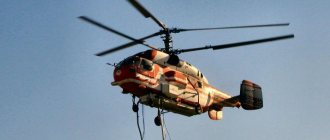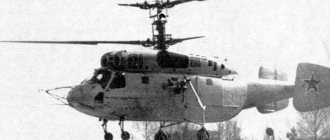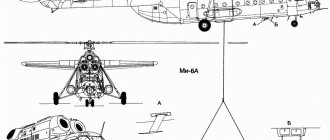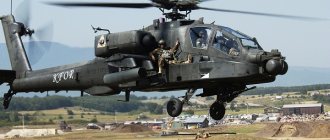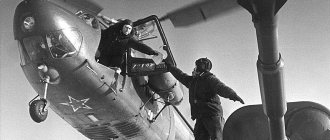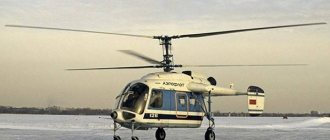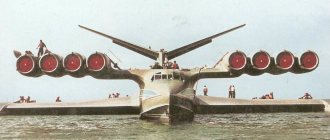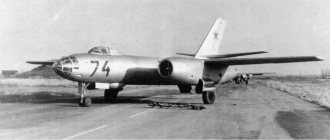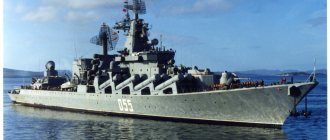Interesting Facts
- The creation of the Mi-6 marked the beginning of the construction in the Soviet Union of helicopters with turboshaft engines.
- During the creation of the Mi-6 had a take-off weight of no more than 15 tons, but our air giant was built with a maximum take-off weight exceeding 40 tons.
- Mi-6's thrust equipment and successful aerodynamic configuration made it possible for the first time in the history of helicopter manufacturing to use an external sling for cargo transportation.
- The Mi-6 was the first in the world to overcome the speed of 300 km/h, which was considered inaccessible for helicopters
- The domestic air giant Mi-6 has 16 world achievements.
- The Mi-6 took part in the liquidation of the consequences at the Chernobyl nuclear power plant; in the area of the village of Rassokha there were several dilapidated radioactive helicopter bodies; currently they have all been melted down.
- In Nizhnevartovsk there is an Aviation Walk of Honor, where the Mi-6 .
- Another interesting fact: in the dashing 90s, Mi-6
Mi-6
Design of the Mi-34 multi-purpose helicopter
The helicopter has a standard single-rotor helicopter design using a tail rotor. The chassis has a simplified design and is represented by skis.
The body is made of aluminum alloy, where CM is widely used, after which the structure passes into the tail boom, on which the casing for the tail rotor is located. The tail boom is equipped with a swept tail on the left side. The cockpit has a large glass area, which provides greater visibility during maneuvers. The helicopter can be controlled by either two or one pilot; control is duplicated for both pilots. Behind the pilots there are two more seats for passengers. There are two doors on each side of the cabin.
The main rotor is represented by a four-blade system, and the blades are elastically attached. The bushing and hinges ensure reliable and elastic rotation of the screw in the horizontal plane. The main rotor blades are rectangular in shape and made of fiberglass reinforced with carbon fiber. The machine's tail rotor has a diameter of 1.98 meters. It consists of two blades that have a pushing function and are also made of fiberglass.
The Mi-34 helicopter is equipped with a nine-cylinder power plant, which is air cooled. The engine is installed in the middle of the helicopter body, equipped with a gearbox and a cooling fan. The power plant has high throttle response and is insensitive to exhaust entering the air intake. The latter characteristic is very important for helicopters that perform very complex maneuvers or sports figures.
The helicopter's tank has a small volume, only 160 liters. It is located in the central part of the machine body and can provide fuel to the engine even in an inverted position. The entire control system is completely mechanical and has a redundant system for two pilots. If not needed, the controls for the left pilot can be removed. The cockpit has modern equipment, which includes an altimeter, radio station, attitude indicator and radio compass.
Production
In the early 50s, the USSR government decided to begin production of a trial batch of GM-1 helicopters, which were called Mi-1, in Moscow. Due to underestimation of the capabilities of helicopters for civil aviation and military purposes, the serial production of the Mi-1 was constantly delayed.
1952-1953 – 30 helicopters were produced at the Kazan aircraft plant No. 387. Since 1954, the Mi-1 began to be mass produced at the Orenburg aircraft plant No. 47, where until 1958 597 helicopters were assembled.
1956-1960 - Rostov plant No. 168 began producing the Mi-1, where 370 aircraft units rolled off the assembly line.
A little later, the USSR aviation industry switched to the production of higher-priority Mi-4 helicopters, and it was decided to move the production of the Mi-1 to Poland. To do this, it was necessary to sign an international agreement, according to which the production of the Soviet helicopter and its components began in the city of Svidnik. 1,683 Mi-1 helicopters of various variants and modifications were assembled in Poland.
History of the creation of the Mi-2
The Mil Design Bureau began designing a new unit at the beginning of 1960. S.P. was appointed the chief designer of this helicopter. Izotov. The decision to design just such a helicopter model truly became a breakthrough in helicopter engineering. The use of two engines for a helicopter's power plant remains relevant today. Moreover, the helicopter body itself remained quite light and compact, which led to an increase in flight speed and increased the vehicle's carrying capacity. The first two prototypes of this machine took off in the fall of 1961. Serial production of the Mi-2 began in 1965 at the Polish helicopter plant Swidnik.
For the fact that the USSR transferred the production of the helicopter to Poland and helped establish serial production of the Mi-2, the OKB employees were presented with Polish state awards, and the chief designers of the helicopter, M.L. Mil and N.S. The squadrons were awarded commander's crosses. Serial production of the Mi-2 was completed in 1992. Over the entire production period of this model, more than 5.5 thousand cars were produced.
The Mi-2 helicopter was first presented to the general public in 1967 at an aerospace exhibition in Le Bourget. At the same time, the helicopter received the international code name “Hoplight”, which was given by the NATO committee. Polish manufacturers also gave this car the name “Marabou”, but it did not catch on.
Mi-2s began to be exported abroad in 1965, but the bulk of the helicopters were purchased by the USSR. This helicopter was also supplied to neighboring countries, to other continents such as Africa and South America.
"Mi" in military service
The first helicopter in the USSR designed specifically for combat was the Mi-24, the famous helicopter that received the unofficial nickname “Crocodile”. In the 1960s, the idea was popular that the further development of ground forces would be associated with increased air mobility. For this purpose, it was planned to create well-armed transport and combat helicopters. Such a vehicle could not only quickly transport an entire army unit over a considerable distance, but also fight using cannon, machine gun and rocket weapons.
Mi-24PN
Thanks to the personal control of Mikhail Leontievich Mil and extensive unification with existing machines, the new helicopter was ready in the shortest possible time. The first flight of the Mi-24 took place in 1969. The flying fire support vehicle took part in combat operations in Afghanistan and Chechnya, more than 3,000 units were produced and is the second most common attack helicopter in the world.
The next generation of combat helicopters is the Mi-28 “air tank”, which took off in 1982. For the state order, the Milevians fought with the Kamov Design Bureau, which presented the original development - the B-80 rotary-wing attack aircraft, the future Ka-50. As a result, the Air Force received two completely different production helicopters. In 1996, a modified Mi-28N “Night Hunter” was developed, which can fight around the clock.
